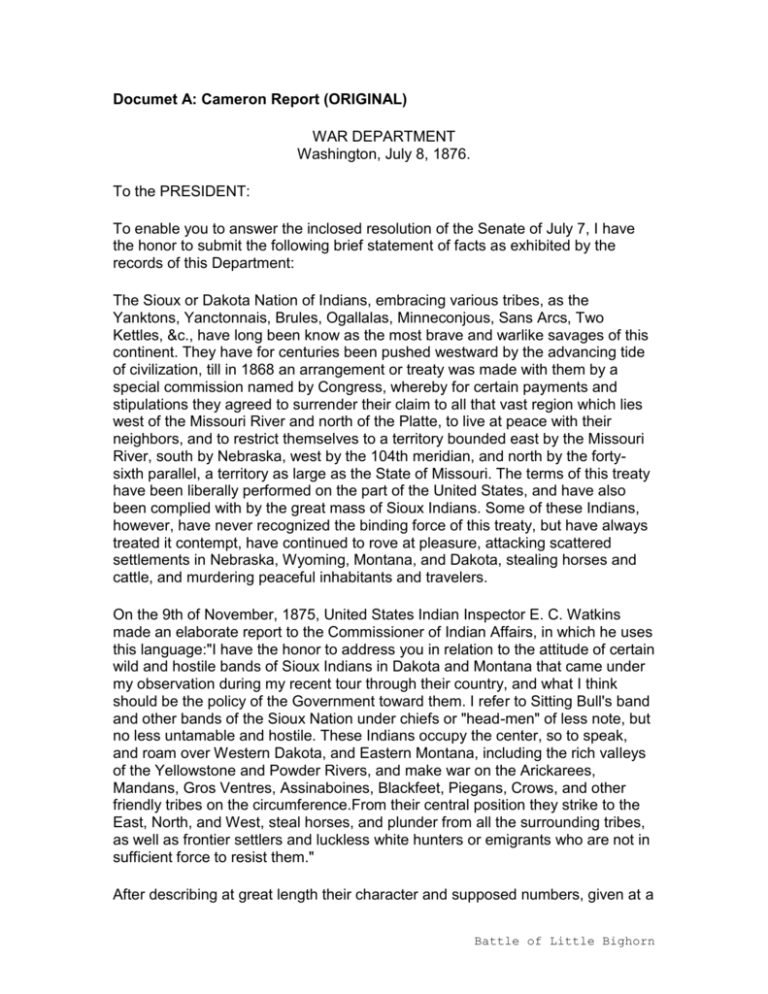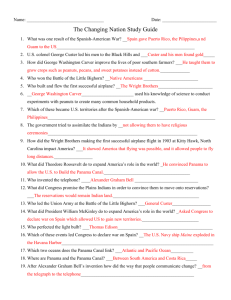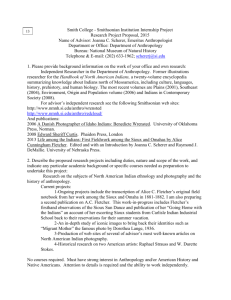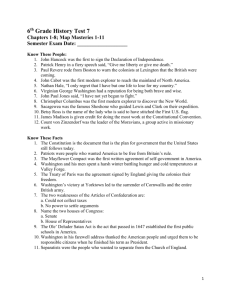Cameron Report Original
advertisement

Documet A: Cameron Report (ORIGINAL) WAR DEPARTMENT Washington, July 8, 1876. To the PRESIDENT: To enable you to answer the inclosed resolution of the Senate of July 7, I have the honor to submit the following brief statement of facts as exhibited by the records of this Department: The Sioux or Dakota Nation of Indians, embracing various tribes, as the Yanktons, Yanctonnais, Brules, Ogallalas, Minneconjous, Sans Arcs, Two Kettles, &c., have long been know as the most brave and warlike savages of this continent. They have for centuries been pushed westward by the advancing tide of civilization, till in 1868 an arrangement or treaty was made with them by a special commission named by Congress, whereby for certain payments and stipulations they agreed to surrender their claim to all that vast region which lies west of the Missouri River and north of the Platte, to live at peace with their neighbors, and to restrict themselves to a territory bounded east by the Missouri River, south by Nebraska, west by the 104th meridian, and north by the fortysixth parallel, a territory as large as the State of Missouri. The terms of this treaty have been liberally performed on the part of the United States, and have also been complied with by the great mass of Sioux Indians. Some of these Indians, however, have never recognized the binding force of this treaty, but have always treated it contempt, have continued to rove at pleasure, attacking scattered settlements in Nebraska, Wyoming, Montana, and Dakota, stealing horses and cattle, and murdering peaceful inhabitants and travelers. On the 9th of November, 1875, United States Indian Inspector E. C. Watkins made an elaborate report to the Commissioner of Indian Affairs, in which he uses this language:"I have the honor to address you in relation to the attitude of certain wild and hostile bands of Sioux Indians in Dakota and Montana that came under my observation during my recent tour through their country, and what I think should be the policy of the Government toward them. I refer to Sitting Bull's band and other bands of the Sioux Nation under chiefs or "head-men" of less note, but no less untamable and hostile. These Indians occupy the center, so to speak, and roam over Western Dakota, and Eastern Montana, including the rich valleys of the Yellowstone and Powder Rivers, and make war on the Arickarees, Mandans, Gros Ventres, Assinaboines, Blackfeet, Piegans, Crows, and other friendly tribes on the circumference.From their central position they strike to the East, North, and West, steal horses, and plunder from all the surrounding tribes, as well as frontier settlers and luckless white hunters or emigrants who are not in sufficient force to resist them." After describing at great length their character and supposed numbers, given at a Battle of Little Bighorn few hundred, he says: "The true policy, in my judgment, is to send troops against them in the winter, the sooner the better, and whip them into subjection. They richly merit punishment for their incessant warfare, and their numerous murders of white settlers and their families, or white men wherever found unarmed."The force estimated as necessary to whip them was one thousand men. This communication was submitted by the Commissioner of Indian Affairs, Hon. Edward P. Smith, to the honorable Secretary of the Interior, Z. Chandler, who in turn submitted it to the then Secretary of War, General Belknap, for his "consideration and action." In subsequent communication of the Secretary of the Interior, of December 3, 1875, to the Secretary of War, occurs this language:"I have the honor to inform you that I have this day directed the Commissioner of Indian Affairs to notify said Indians (Sitting Bull and others outside their reservation) that they must remove to the reservation before the 31st day of January, 1876; that if they neglect or refuse so to remove, that they will be reported to the War Department as hostile Indians, and that a military force will be sent to compel them to obey the orders of the Indian Office." On the 1st day of February the Secretary of the Interior further notified the Secretary of War:"The time given him (Sitting Bull) in which to return to an agency having expired, and the advice received at the Indian Office being to the effect that Sitting Bull still refuses to comply with the directions of the Commissioner, the said Indians are hereby turned over to the War Department for such action on the part of the Army as you may deem proper under the circumstances." During all the stages of this correspondence, the General of the Army and his subordinate commanders were duly notified, and were making preparations for striking a blow at these hostile savages, an enterprise of almost insurmountable difficulty in a country where, in winter, the thermometer often falls to forty degrees below zero, and where it is impossible to procure food for man or beast. An expedition was fitted out under the personal command of Brig. Gen. George Crook, an officer of great merit and experience, which, in March last , marched from Forts Fetterman and Laramie to the Powder River and Yellowstone Valleys, struck and destroyed the village of Crazy Horse, one of those hostile bands referred to by Indian Inspector Watkins, but the weather was found so bitter cold, and other difficulties so great arose, that General Crook returned to Fort Laramie in a measure unsuccessful so far as the main purpose was concerned. These Indians occupy parts of the Departments of Dakota and Platte, commanded by Generals Terry and Crook, respectively, but the whole is immediately commanded by Lieutenant-General Sheridan, who has given the matter his special attention. Preparations were then made on a larger scale, and three columns were put in motion as early in May as possible, from Fort Abe Lincoln, on the Missouri River, under General Terry; from Fort Ellis, in Montana, under General Gibbon; and from Fort Fetterman under General Crook. These columns Battle of Little Bighorn were as strong as could be maintained in that inhospitable region, or could be spared from other pressing necessities, and their operations are not yet concluded, nor is a more detailed report deemed necessary to explain the subject-matter of this inquiry. The present military operations are not against the Sioux Nation at all, but against certain hostile parts of it which defy the Government, and are undertaken at the special request of that bureau of the Government charged with their supervision, and wholly to make the civilization of the remainder possible. No part of these operations are on or near the Sioux reservation. The accidental discovery of gold on the western border of the Sioux reservation, and the intrusion of our people thereon, have not caused this war, and have only complicated it by the uncertainty of numbers to be encountered. The young warriors love war, and frequently escape their agents to go on the hunt, or warpath, their only idea of the object of life. The object of these military expeditions was in the interest of the peaceful parts of the Sioux Nation, supposed to embrace at least nine- tenths of the whole, and not one of these peaceful or treaty Indians have been molested by the military authorities. The recent reports touching the disaster which befell a part of the Seventh Regular Cavalry, led by General Custer in person are believed to be true. For some reason as yet unexplained, General Custer, who commanded the Seventh Cavalry, and had been detached by his commander, General Terry, at the mouth of Rosebud, to made a wide detour up the Rosebud, a tributary of the Yellowstone, across to the Little Big Horn and down to the mouth of the Yellowstone River. Yates; Lieutenants Cook, Smith, McIntosh, Calhoun, Hodgson, Reilly, Porter, Sturgis, all of the Seventh Cavalry; and Lieutenant Crittenden of the Twentieth Infantry, Lieutenant Harrington, Assistant Surgeon Lord, and Acting Assistant Surgeon DeWolff, are missing. The wounded were carried back to the mouth of the Big Horn, in the Yellowstone River, which is navigable, and where there were two steamboats, one of which was sent down the river to Fort Abe Lincoln with the wounded, and to communicate these sad facts. General Terry is therefore at the mouth of the Big Horn, refitting, and will promptly receive re-enforcement and supplies, and will resume his operations immediately. Meantime, General Crook had also advanced from Fort Fetterman, and on the 17th of June, eight days before General Custer's attack, had encountered this same force of warriors on the head of the Rosebud, with whom he fought several hours, driving the Indians from the field, losing nine men in killed; one officer and twenty men wounded. General Crook reports his camp as on Tongue River, Wyoming. Re-enforcement and supplies are also enroute to him, and every possible means have been adopted to accomplish a concert of action between Battle of Little Bighorn these two forces, which are necessarily separated, and are only able to communicate by immense distances around their rear. The task committed to the military authorities is one of unusual difficulty, has been anticipated for years, and must be met and accomplished. It can no longer be delayed, and everything will be done by the Department to insure success, which is necessary to give even an assurance of comparative safety to the important but scattered interests which have grown up in that remote and almost inaccessible portion of our national domain. It is again earnestly recommends that the appropriation asked for repeatedly by General Sheridan, of $200,000, be made, to build two posts on the Yellowstone, at or near the mouths of the Big Horn and Tongue Rivers. Inclosed herewith please find copies of General Terry's report, just received by telegraph since the preparation of this letter. Very respectfully, your obedient servant, J. D. CAMERON, Secretary of War. Source: The President of the United States asked the Secretary of War, J.D. Cameron, for a report of the military actions leading up to the Battle of Little Bighorn. Battle of Little Bighorn Document B: Kate Bighead Interview (ORIGINAL) Little Big Horn was not the first meeting between the Cheyennes and Long Hair. Early in the winter of 1868 Long Hair and the Seventh Cavalry attacked our camp on the Washita River killing Chief Black Kettle and his band, burning their tipis and destroying all their food and belongings. In the spring Long Hair promised peace and moved the Cheyenne to a reservation. When gold was discovered white people came and the Indians were moved again. My brothers and I left for the open plains where our band of Cheyenne was again attacked by white soldiers in the winter of 1875. We were forced to seek help from a tribe of Oglala Sioux led by Chief Crazy Horse. After several days we joined Sitting Bull and the Hunkpapa Sioux and decided to travel and hunt together as one strong group. As conditions on the reservations became worse more and more Indians migrated west joining our group. Six tribes lived peacefully for several months, hunting buffalo, curing the meat for the winter months, and tanning buffalo hides. In the early summer, 1876 we set up camp near Little Big Horn River. Soldiers were spotted by some hunters to the south of the camp. Some young men went off to fight them and when they returned the next day they carried the bodies of several dead warriors with them. The chiefs then decided the group should move to the mouth of the river where there was plenty of game. On the first day of camp the peace was shattered when two boys ran into the camp warning of soldiers. Then shooting could be heard. Women and children went to hide in the brush, some women carried away tipis and their belongings, others just ran with their children. Old men helped young men put on their war paint and dress. War ponies were brought into camp from the herds and the warriors mounted them and galloped away. I found a pony and followed the warriors to watch the fighting as I often did since my nephew, Noisy Walking, expected me to watch and sing songs to give him courage. I rode around the outer fringes of the fighting, staying out of range of the bullets as I searched for Noisy Walking. In this way I could see what was happening. More and more soldiers were getting off their horses, preferring to hide or crawl along the ground. The ride by the river became a focal point as bands of warriors moved toward the waiting soldiers. Hundreds of Indians had begun to crawl toward them along crevices and gullies. Some soldiers mounted an attack off the ridge, galloping on their horses toward a group of Cheyennes and Oglalas. The Indians scattered to safety, and the white men dismounted again to hide along a second ridge. As hundreds of Indians surrounded this ridge I saw one of the soldiers point his pistol at his head and pull the trigger. Others imitated his example, shooting sometimes themselves, sometimes each other. When Chief Lame White Man reached the soldiers all of them were already dead. Indians then attacked the first ridge, and again most of the white men were already dead. The only thing remaining for the Indians to do was pick up the abandoned guns and ammunition. As warriors walked among the white men, they cut off the legs or feet or arms of many of the bodies. Some of the soldiers were still living, having only been wounded, but they were quickly killed and parts of their bodies were also severed. Battle of Little Bighorn Only a few soldiers were still alive and able to fight at this point, and they joined forces at the west end of the ridge where they were surrounded by warriors and killed. When the shooting stopped the Indians thought all the soldiers had been killed, but seven soldiers were still alive and they rushed out from behind their horses and started running. I could not see what happened to these seven because of all the dust raised by the Indians and their ponies. I rode away searching for my nephew who had been shot and stabbed. I stayed with him, and brought him to his mother, but Noisy Walking died that night. He was one of the few Indians to be killed -- only half a dozen Cheyennes and two dozen Sioux lost their lives. The Indians said this was because of the Everywhere Spirit who had caused the white men to go mad and kill themselves thus saving many lives from the guns of the soldiers. They said this madness was the Everywhere Spirit's way of punishing the white men for attacking a peaceful Indian camp. After the battle according to Cheyenne custom the dead were buried while some of the Sioux dead were placed on scaffolds. Then lodges and tipis were dismantled and we traveled down river when we received word that more soldiers were coming toward Little Big Horn. When we reached the junction of the Little Big Horn and Powder Rivers the group divided and the Cheyenne made camp near the mouth of the Powder River. Soldiers once again attacked us during the winter destroying our food and hides, so we moved into the Little Big Horn Valley. We were finally persuaded to go with the soldiers and sent to Oklahoma. Source: Kate Bighead, a Cheyenne Indian, told this story to Dr. Thomas Marquis in 1922. Dr. Marquis was a doctor and historian of the Battle of Little Bighorn in the 1920s. He interviewed and photographed Cheyenne Indians. Battle of Little Bighorn









